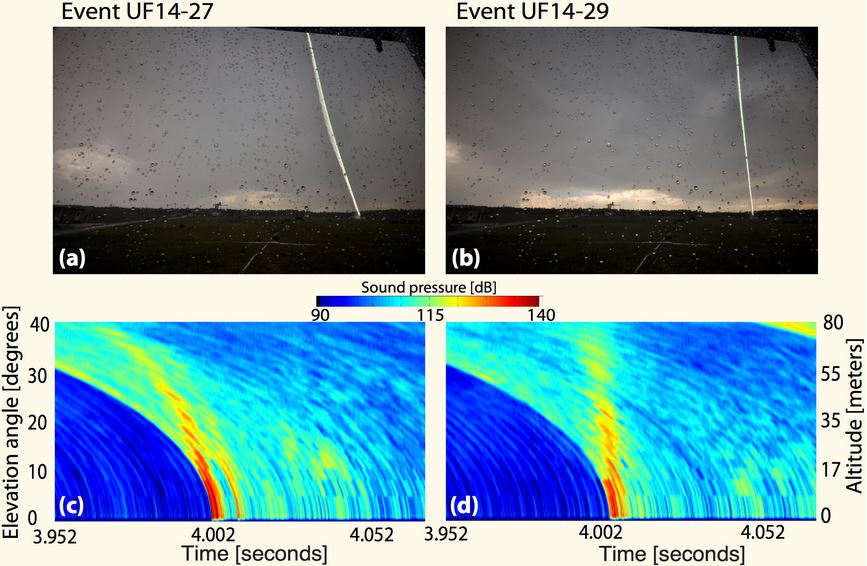Scientists have produced the most amazing images of thunder by shooting rockets into thunderstorms on a US military base outside Gainesville in Florida. The pictures represent the acoustic energy that blasts outwards in ripples as lightning bolts strike from the heavens.
The researchers, from Southwest Research Institute (SwRI), presented the first images at a joint meeting of the American & Canadian geophysical societies in Montreal (May 3-7).
Lightning and thunder poorly understood
Dr. Maher A. Dayeh, a research scientist in the SwRI Space Science and Engineering Division, said:
“Lightning strikes the Earth more than 4 million times a day, yet the physics behind this violent process remain poorly understood. While we understand the general mechanics of thunder generation, it’s not particularly clear which physical processes of the lightning discharge contribute to the thunder we hear.”

Optical photographs of 2 triggered lightning events (top) compared with acoustically imaged profiles of the discharge channel (below). The tilt of the lightning bolt in the left photo is also seen in the acoustic image. (Image: swri.org)
“A listener perceives thunder largely based upon the distance from lightning. From nearby, thunder has a sharp, cracking sound. From farther away, it has a longer-lasting, rumbling nature.”
Although we see it as a flashing bolt, lightning starts as a complex process of electrostatic charges milling around in storm clouds.
These charges initiate step leaders (paths of ionized air stemming from a cloud), branching veins of electricity propagating down, which eventually lead to a main discharge channel.
That channel unlocks a path to almost instantaneous return strokes, which form the lightning flash we all see.
By studying the acoustic power radiated from various parts of the lightning channel, scientists can gain more insight into the origins of thunder, as well as the energetic processes related to lightning.
Triggering lightning
Dr. Dayeh said:
“Thunder and lightning are fascinating, wild, and unpredictable. Because of their erratic nature, the phenomena are best studied using triggered events.”
A triggered event here means causing lightning artificially. The researchers launch a small rocket trailing a grounded copper wire into thunderclouds. The copper wire provides a conductive channel and creates a predictable path for lightning.
If scientists know the lightning bolt’s path precisely beforehand, they can set up all their equipment pointing at where they know the bolts will strike, and carry out a series of experiments.
Dr. Dayeh and colleagues carried out a proof-of-concept experiment to capture images of the acoustic signature of thunder, i.e. photograph the ‘sound’ of thunder.
The experiments were done at the International Center for Lightning Resarch and Testing at the University of Florida, Gainesville. Florida boasts the highest annual number of lightning strikes in the United States.
Dr. Dayeh designed a large, sophisticated arrangement of microphones to study thunder’s acoustic signature. Fifteen microphones were placed one metre apart, ninety-five metres from the rocket launch pad where the triggered lightning would strike.
To capture images of the bolt’s vertical profile, the team used the post-signal processing techniques and directional amplification of the data signals captured by the microphones.
Dr. Dayeh said:
“At first I thought the experiment didn’t work. The initial constructed images looked like a colorful piece of modern art that you could hang over your fireplace. But you couldn’t see the detailed sound signature of lightning in the acoustic data.”
However, when the scientists looked at different sound frequency bands, they noticed that the images cleared up at higher frequencies.
The technique produced a distinct signature of thunder generated by the lightning bold.
The authors wrote that “future experiments could allow scientists to study the probable acoustic signatures of current pulses, step leader branches, and discharge channel zigzags independently.”
Video – Triggering lightning with rockets

